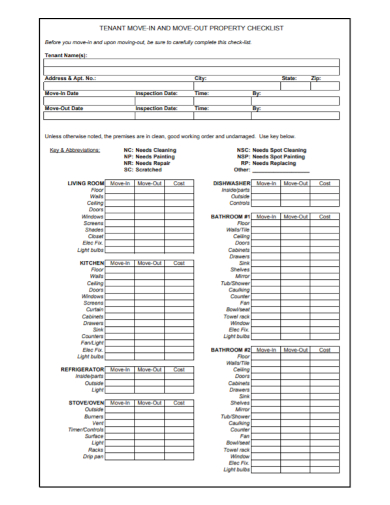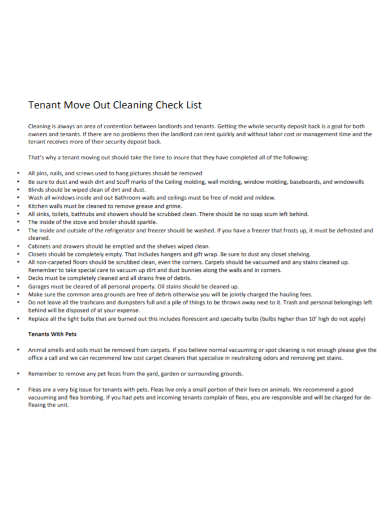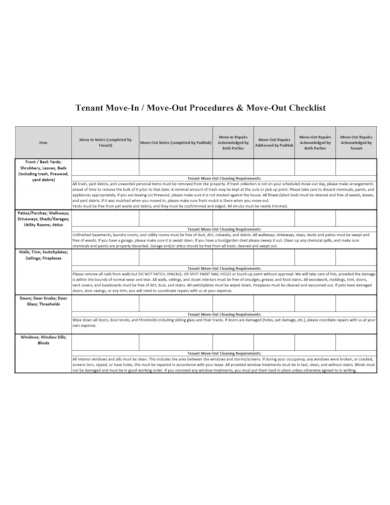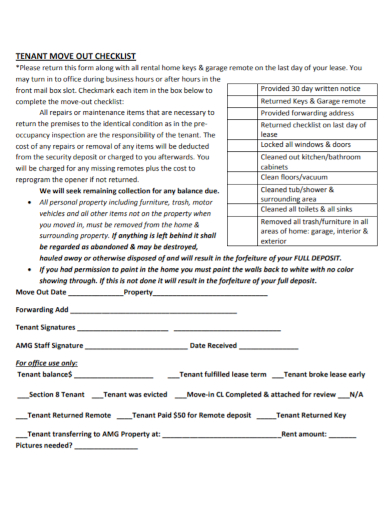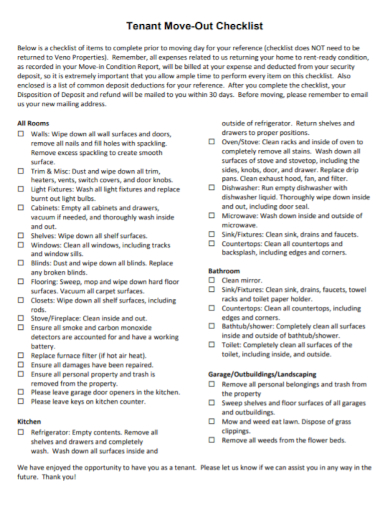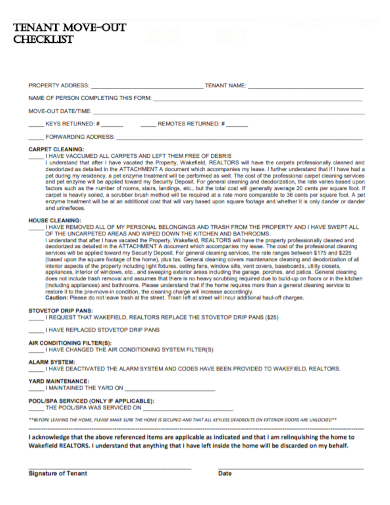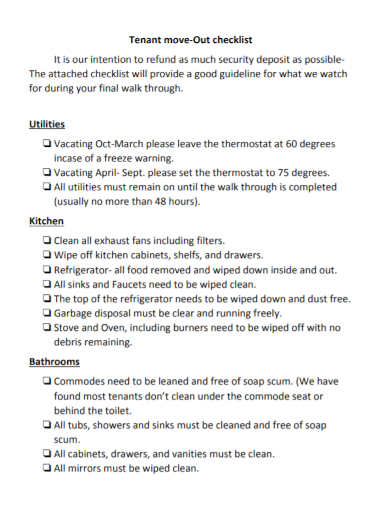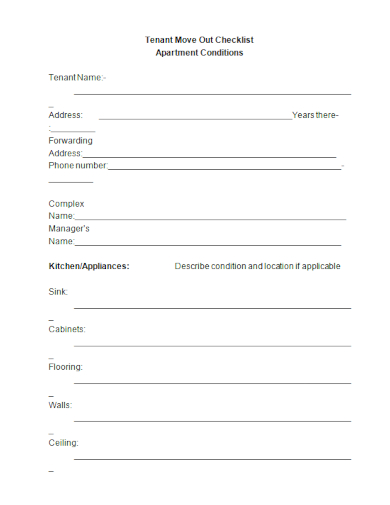When it’s time for a tenant to move out, you want the process to go as smoothly as possible so that new tenants can be screened and onboarded without delay. Much of the move-out process is ensuring that the tenant adheres to the contract and leaves you with as little to do as possible. While you, of course, cannot control everything, a clear process coupled with frequent communication helps enable your tenants to do their part and prepares you to deal with the situation in the case that they do not fulfill their contractual responsibilities. This article will guide you on how to make a tenant move out checklist.
10+ Tenant Move Out Checklist Samples
1. Tenant Move Out Property Checklist
2. Tenant Move Out Cleaning Checklist
3. Tenant Landlord Move Out Condition Checklist
4. Tenant Move Out Procedure Checklist
5. Tenant Move Out Checklist
6. Sample Tenant Move Out Checklist
7. Standard Tenant Move Out Checklist
8. Printable Tenant Move Out Checklist
9. Basic Tenant Move Out Checklist
10. Formal Tenant Move Out Checklist
11. Apartment Tenant Move Out Checklist
What is a Move-Out Checklist?
A move-out checklist is a list that details all the important aspects of a thorough move-out inspection. Both landlords and tenants can use it. These lists may also act as an apartment cleaning checklist. They cover many of the same topics. There are general move-out inspection checklists available online. However, it’s best for landlords to provide tenants with an inspection checklist that is tailored to a specific unit. If there are move-out instructions within the lease agreement, both landlords and tenants must abide by them. This helps to avoid any problems after move-out. Those problems could include tenants leaving furniture behind, an uncleaned unit, and even forgotten keys.
Details to Include in a Tenant Move Out Checklist
Move-out Checklist: Living Spaces and Bedrooms
- Walls – Walls should be free of any markings or damage. Holes left should be filled according to the lease agreement.
- Floors – Hard flooring should be free of scratching or any deep grooves. Carpets shouldn’t be excessively stained or burned. Carpets should be vacuumed and hard floors should be swept and mopped.
- Closets – Closets should be completely empty, dusted, and the floors cleaned.
- Ceiling Fans and Central Air Vents – These need to be dusted and wiped down with a wet cloth.
- Windows – Windows shouldn’t have any cracks. They should be washed from the inside with a glass cleaner. Curtains should be removed. Blinds, typically provided by the landlord, should be wiped clean between each blade to remove dust and debris.
Move-out Checklist: Kitchen
- Stovetop and Range Hood – Stovetops should be cleared of food and debris. Drip plates that are excessively burned or rusted will need to be replaced. Range hoods with lights and fans should be degreased.
- Oven – The oven should be cleared of excess buildup and degreased. Oven racks should be cleaned or replaced, as needed.
- Backsplash – Any backsplash in the sink area or near the stovetop will collect grease and debris. People should clean and degrease those as needed.
- Dishwasher – Tenants should clean the dishwasher filter regularly. There shouldn’t be any bits of food in the dishwasher in the dishwasher after move-out.
- Sink and/or Garbage Disposal – People should clean and clear the sink of any excess food.
- Floors – Floors should be free of excess marking or scuffing. Tenants or landlords should sweep or mop them.
- Cabinets – Cabinets should be completely empty. Tenants should remove any crumbs or trash. Doors should be secured on their hinges and shelves should not sag.
- Countertops – People need to clean and degrease countertops. The landlord could consider any burns, cuts, or large stains to be excessive damage.
- Refrigerator and Freezer – These should be empty and clean. The tenant may need to defrost the freezer.
- Microwave – The tenant or landlord should degrease and thoroughly clean microwaves from the inside out.
- Windows – Windows in the kitchen may collect grease. The tenant or landlord should clean them accordingly.
Note: All appliances throughout the unit should be in good working condition. Landlords should perform routine maintenance checks throughout the lease term. That way, they can make sure they’re making repairs even if tenants do not report them.
Move-out Checklist: Bathroom
- Toilet – Should be cleaned and disinfected.
- Shower/Bathtub – Showers and bathtubs should be clear of personal items and shower curtains. The tenant or landlord should clean and disinfect them.
- Sink – The sink should be unstained and free of personal effects. It should be cleaned and disinfected.
- Floors – People need to sweep and mop the floors.
- Mirrors – Mirrors should be wiped down with a glass cleaner and be free of cracks. If the mirror also acts as a medicine cabinet, it should be empty.
- Windows – Landlords or tenants should clean windows with a glass cleaner from the inside.
Note: Mold is a common issue in bathrooms, as it’s a moist environment. If the problem is extensive, an expert should perform mold removal. Landlords or tenants should check the bathroom fan regularly to ensure that it’s working. That’ll greatly reduce the chances of a mold problem.
Move-out Checklist: Miscellaneous.
- Smells – If there are any lingering odors in the apartment that airing out will not fix, landlords could consider that to be excessive damage.
- Utilities – Tenants will need to take their name off of their utilities upon move-out. If the utilities are in the landlord’s name, they should turn them off while the unit is unoccupied.
- Keys – Tenants should return their keys to the landlord upon move-out. Some landlords require tenants to pay a fee for any keys that they don’t return.
If you have expressly prohibited smoking or pets in the apartment, but the smell comes from animal urine or cigarette smoke, you can consider it a breach of the lease. If this is the case, you may need to write a notice to vacate prior to the end of the lease term.
FAQs
Why is a move-out checklist important?
Move-out checklists are especially important when it comes to the security deposit. Security deposit disputes are a big issue between landlords and tenants. If the tenant understands the proper procedures for move-out, including the condition they are supposed to leave the rental property in, it will help minimize these issues. Following these instructions, and adhering to the terms of their lease, will help ensure the tenant receives their security deposit back in full.
What is normal wear and tear?
The definition of normal wear and tear varies from state to state and can be difficult to precisely define. But generally speaking, wear and tear are what would occur no matter who lived in the house, including yourself. Another way to think about wear and tear is by using the IRS guidelines for the lifespan of certain assets in a rental property. The IRS considers an appliance such as a refrigerator to fully depreciate over only five years. Of course, that doesn’t mean you’re going to replace the refrigerator in a rental property every five years. But this does give you a good idea of how long some items are expected to last due to normal wear and tear.
Regardless of circumstances, tenants and landlords should strictly adhere to any move-out rules or guidelines that the lease agreement includes. Both landlords and tenants are legally bound by their agreement. If a dispute arises, be sure to have time-stamped photographs on hand. Those will help you ensure that you have evidence of your argument.
Related Posts
FREE 17+ Survey Checklist Samples in MS Word | Google Docs | PDF
FREE 18+ Background Checklist Samples in MS Word | Google Sheets | PDF
FREE 18+ Facilitator Checklist Samples in MS Word | Google Sheets | PDF
FREE 18+ Complaint Checklist Samples in MS Word | Google Sheets | PDF
FREE 18+ Internship Checklist Samples in MS Word | Google Docs | PDF
FREE 18+ Statement Checklist Samples in MS Word | Google Sheets | PDF
FREE 20+ Voluntary Checklist Samples in MS Word | Google Sheets | PDF
FREE 18+ Summary Checklist Samples in MS Word | Google Sheets | PDF
FREE 14+ Sponsorship Checklist Samples in MS Word | MS Excel | PDF
FREE 18+ Conference Checklist Samples in MS Word | Google Sheets | PDF
FREE 17+ Lesson Checklist Samples in MS Word | Google Sheets | PDF
FREE 18+ Progress Checklist Samples in MS Word | Google Docs | PDF
FREE 18+ Enrollment Checklist Samples in MS Word | Google Docs | PDF
FREE 18+ Graduation Checklist Samples in MS Word | Google Sheets | PDF
FREE 15+ Consent Checklist Samples in MS Word | Google Sheets | PDF

